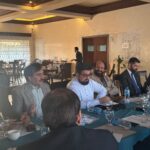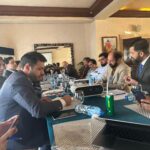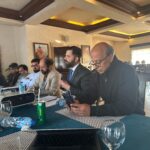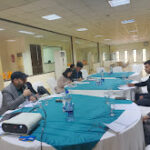Pakistan’s Militancy and Insurgency Landscapes in 2024-25
According to Pakistan Security Report 2024, prepared and released by the Pak Institute for Peace Studies (PIPS), there has been a significant 70% increase in terrorist activities across Pakistan in 2024. Despite that surge in terrorism, factors such as weak political will, economic instability, and strained relations with Afghanistan further complicate Pakistan’s countering terrorism challenge.
To analyze the prevailing security circumstances, PIPS conducted a series of Focus Group Discussions in Islamabad on January 7, 2025. The key themes of these discussions were: “Nationalist Insurgency Groups in Balochistan 2024-25” and “The Militant Landscape of Pakistan 2024-25”.
Discussants
- Abdullah Khan, Director, Pakistan Institute for Conflict and Security Studies (PICSS),
- Muhammad Israr Madani, President International Research Council for Religious Affairs, Islamabad
- Imtiaz Gul, Executive Director, Center for Research & Security Studies
- Anwar Bangash, Political and Information Assistant at Embassy of Poland
- Azaz Syed , Author & Journalist at Jung and Geo Group
- Aarish U. Khan, Research Analyst, Institute of Regional Studies
- Aoun Sahi, Journalist & Former Director News Pakistan Television
- Kamran Yousaf, Anchor Person & Journalist
- Azam Khan, Independent Journalist
Key Findings
Diverse themes and patterns were discussed in relation to the resurfacing of terrorism and insurgency in the country, however, within the rigorious discussions, the following areas received the greater consensus among the participants.
- Shift in Militants’ Strategies
According to most experts, terrorist and insurgent groups, specifically Tehreek-e-Taliban Pakistan (TTP) and the Balochistan Liberation Army (BLA), have shifted their targeting strategies.
Following the change in TTP leadership and the Afghan Taliban’s capture of Kabul, the TTP altered its focus from targeting civilians in the past to prioritizing attacks on security forces. In a recent statement released via its Umar Media outlet, the TTP leadership, particularly Noor Wali Mehsud, explicitly directed its fighters to refrain from targeting civilians. However, the statement also issued an ultimatum, demanding civilians withdraw their investments from military-owned businesses and corporations within three months.
Similarly, the BLA has redirected its efforts towards targeting security forces with coordinated, high-impact atatcks including fedayee assaults. According to the Pakistan Security Report 2024 by PIPS, security forces and law enforcement personnel have borne the brunt of attacks and casualties caused by the BLA and other smaller nationalist insurgent groups.
- Production and Propagation of Propeganda Literature
Parallel to their lethal attacks, terrorist and militant groups have channeled significant resources into enhancing the depth and professionalism of their literature and text production. Among militants in Pakistan, the TTP, IS-K, and BLA stand out for their robust media outlets, respectively. In the past, Al-Qaeda was the primary source of text production for such groups. However, these organizations have now acquired considerable expertise, and their recent publications reflect professionalism and sophistication.
TTP’s Umar Media, operating under its so-called ministry of broadcasting and information, produces daily radio broadcasts, a twice-weekly podcast on current affairs, and an Urdu magazine. This outlet publishes materials in Urdu, Dari, Pashto, and English. Meanwhile, the BLA has effectively utilized social media platforms to propagate its discourse, justify acts of violence, and create appealing content aimed at potential recruits. Their outreach includes platforms like Telegram, Rumble, and WhatsApp groups.
- Inadequate State Response: A Cartalyst for Citizen Mistrust
The state’s internal political dealings and lack of a clear stance regarding the terrorism threat have fostered an atmosphere of mistrust between the state and its people. Pakistan’s recent airstrikes inside Afghanistan, conducted while a diplomatic envoy was present there, underscore a lack of coordination between the civilian and military leaderships regarding Afghanistan—an important neighbor, particularly given the current security situation.
In Kurram, the state has failed to assert its authority over the affected region to prevent further violence. The recent agreement between the two sides in Kurram has not inspired confidence, leaving an air of hopelessness among the population.
Moreover, on critical national issues, the current government has remained dormant and largely invisible. These factors have exacerbated the mistrust between the state and its citizens, especially those in peripheral areas, complicating efforts to tackle terrorism and militancy. In this context, the state’s reliance on kinetic force alone may prove ineffective.
Expert Insights
- Abdullah Khan
There has been a noticeable shift in the TTP’s strategies regarding their targets in recent years. They now focus more on targeting security forces compared to civilians, who were their primary targets in the previous decade. Also, the TTP is leveraging the narrative of the Pashtun Tahafuz Movement to their advantage. This shift appears to be an attempt to improve their public image.
Groups like the BLA, IS-K, and TTP often target similar entities, highlighting that both the BLA and TTP pose significant threats. This is particularly concerning at a time when IS-K’s activities are in decline. The cooperation and operational capabilities shared between these groups further emphasize their threat level.
Among them, the TTP is comparatively stronger and, with operational support from the Afghan Taliban, presents a more dangerous threat to Pakistan than the BLA at present. However, internal feuds and strategic differences within the TTP could impact this shift in priorities. For one, factions like Jamaat-ul-Ahrar, under the TTP’s umbrella, oppose the change in strategy under Noor Wali Mehsud’s leadership, which prioritizes targeting security forces over civilians. This internal dissent could potentially lead to a rollback of these priorities, reverting to strategies employed in the past.
- Israr Madani
Most Deobandi militant groups, including the TTP, remain geographically limited despite harboring global aspirations. In tribal areas, individuals involved in petty crimes have risen to become commanders of the TTP. There can be seen advancements in the professionalism of the TTP’s text production, with a noticeable shift in targets from civilians to security forces. In the past, both the TTP and the Afghan Taliban relied on Al-Qaeda for their textual narratives; now, they produce these materials independently.
With regard to deteriorating relations between the state—specifically the military—and the Shia community, particularly in Kurram, the religious leadership of the Shia community is largely tolerant and opposed to sectarianism and violence. However, recent violence has also instilled fear in the bureaucracy and military. While an operation in Kurram was announced as part of a negotiated agreement, its implementation appears highly challenging. The detrimental role of social media in spreading hate and fueling recent sectarian violence against both the state and between sects has been visible to all.
The military and bureaucratic apparatus have, to some extent, compartmentalized the Shia and Sunni populations to maintain order and prevent violence. The ulema have lost faith in both the government and the TTP.
Within the dormant perceptions of the Kandahari Taliban, the TTP are viewed as not entirely Mujahideen. The Kandahari Taliban, who are the most influential faction among the Afghan Taliban, exercise strong control over key ministries, including defense and interior, even when they are not formally in charge.
- Tahir Khan
TTP and some smaller factions had already established a presence in the southern KP districts. The interconnectedness of these districts, along with their shared border with Taliban-controlled Kabul, facilitates TTP’s ability to carry out attacks more easily. The deteriorating security situation may be attributed to the state’s apparent lack of sincerity, weak commitment, and poor coordination between the provincial and central governments.
The Afghan Taliban are not in favor of a destabilized Pakistan. The TTP’s evolving strategy of not targeting civilians might not last long. At some point, TTP could grow frustrated with civilians, which might significantly influence a reversal of their strategy.
The TTP has become a liability for the Afghan Taliban, who find it difficult to disentangle themselves from the group. On the other hand, Pakistan is unlikely to back down from its kinetic approach to dealing with TTP. That means we have challenging times ahead.
There have also been rumors about the relocation of TTP, but these are only conspiratorial, as the terms and conditions discussed in those alleged talks do not align with the stance of the Pakistani state.
Following Pakistan’s airstrikes inside Afghanistan, the agreements between Kabul’s current rulers and Pakistan—including political visits by leadership from both sides, the Free Trade Agreement (FTA), and other official engagements—are now likely to face delays before being revived.
- Aarish Khan
Negotiations are not inherently negative, although the grounds for negotiation remain contentious. The current civilian and military leaderships have consistently criticized the former government’s negotiations with the TTP. However, there is a notable lack of clarity in their approach—for instance, recent airstrikes within Afghanistan were carried out despite having an envoy present in the country.
The situation could deteriorate further. Pakistan’s counterterrorism strategy has been fragmented, inadvertently turning allies into adversaries. If terrorist groups were to exploit any human rights movement to their advantage, it would highlight the state’s incapacity to counter such efforts effectively.
One can only emphasize the importance of local empowerment and ownership in decision-making processes, because there are concerns over their apparent neglect.
- Kamran Yousaf
The increase in the activities of Baloch insurgent groups since the U.S. withdrawal from Afghanistan is significant and suggests intensified foreign involvement. It is peculiar that these groups perceive Chinese investments as the sole threat while disregarding others, indicating that external forces might be influencing their agenda. However, the rise of these nationalist insurgent groups stems from the state’s shortsighted policies.
Moreover, vulnerabilities leave no room for adversaries’ sympathies. Of particular concern is the recruitment of educated youth by the Balochistan Liberation Army, with women increasingly taking active roles in their operations.
To address Balochistan’s grievances, potential remedies include free and fair elections, strengthened local representation, and the redirection of some Chinese projects toward human development initiatives in the region.
- Imtiaz Gul
Curbing terrorism requires a comprehensive and formal policy, yet we continue to rely on short-term fixes. The primary causes of the worsening situation include: A warlord-based approach to Afghanistan aimed to suppress Pashtun notion but has backfired.
Political bargaining within the country is another problem. For example, the state’s handling of the madrasa reform bill reflects its tendency to prioritize short-term political gains. Thridly, the Haqqani network, treated as a “blank check,” represents a deeply ingrained issue in Pakistan’s strategic thinking.
Proxies are a form of terrorism, fueling and exacerbating its spread. The state manipulates various groups’ power dynamics and grievances to its advantage. Pakistan needs a trilateral consensus involving China, India, and Pakistan to move away from its reliance on proxies.
Regarding Kurram, certain individuals incite rival factions, pushing them toward attacks.
Terrorists are inflicting significant harm on the country’s security apparatus. The root cause lies in Pakistan’s internal dealings and continued use of proxies.
- Anwar Bangash
Violence in Kurram is a manifestation of terrorism, as any dispute in the region can quickly escalate into acts of terror, unlike other parts of the former FATA region. Various terrorist groups are also active in the Kurram district. Furthermore, Kurram has a history of sectarian conflict, influenced by historical Middle Eastern proxy wars and the implications of recent developments in the region.
There is a perception among the people of Kurram, particularly those from the Shia sect, that the state seeks to engage Shias in Kurram to prevent their involvement in conflicts in the Middle East, such as Syria.
The recent agreement reached in Kurram was signed under duress and is unlikely to produce meaningful results. There is surprising alignment of the Hafiz Gul Bahadur Group and IS-K, who, despite being enemies, appear to collaborate against the Shia community in Kurram.
There is lack of coordination within the state, as well as between the central and provincial governments, questioning their seriousness in addressing the issue.
As far as the role of social media in the Kurram violence is concerned, many incidents depicted in videos circulating online are not recent but from the distant past, and they are being used solely to escalate the conflict.
- Aoun Sahi
Information has been securitized, and Kurram has become a black hole of information, leaving social media as the only outlet. This has amplified the detrimental effects of propaganda in the ongoing violence. The recent efforts of the Pashtun Jirga, formed in October last year to resolve the violence in Kurram, fell victim to this social media propaganda, preventing them from brokering a deal.
A prominent pattern in these social media posts is the use of intertextuality and the discursive framing of current events in relation to distant historical events, such as “Karbala” and other occurrences from that era. Recently, the TTP released a statement warning civilians to withdraw their investments from military businesses—a narrative that parallels the propaganda campaign of PTI.
- Azaz Syed
The divergence between civilian and military approaches to countering terrorism has not yielded effective results overall. Policies from both sides have often fallen short. However, civilian policies supported by military cooperation have proven fruitful in some instances, with the Swat operation serving as an example.
Currently, there is a dilemma regarding whether the present government truly represents the will of the people—a concern that also plagued the Imran Khan administration—further darkening the situation. The current leadership has been conspicuously absent in addressing several critical national issues, including the violence in Kurram and the deteriorating security situation in Khyber Pakhtunkhwa.
Moreover, there is a glaring lack of coordination between civilian and military institutions, compounded by internal discord within the military itself. The state continues to rely exclusively on hard power, neglecting the use of soft power strategies, which has led to the alienation of the youth in Balochistan.
Nationalist insurgent groups pose a significant threat, as they could serve as an effective tool for global powers to undermine China’s interests in Pakistan, ultimately making Pakistan a direct victim of such machinations.
- Azam Khan
The people in Kurram specifically lost trust in the government and military apparatus. Due to the complexity of Kurram violence, it has become a local, national, international, and sectarian issue at once.
Recommendations
The experts provided the following recommendations for addressing the unfolding security situation in the country:
- Local empowerment, particularly in peripheral areas, should be enhanced, along with increased representation in the decision-making process.
- In the case of Balochistan, emphasis should be placed on recognizing culture and identity, followed by free and fair elections and the establishment of a strong justice system. Additionally, if possible, negotiations should be pursued with all willing militants. If this is not feasible, at the very least, the political representatives, such as Akhtar Mengal and Mahrung Baloch, should be given an opportunity to voice their concerns.
- Counterterrorism policies, both individual and tenure-based, need to be revised. A civilian-led, holistic national security policy should be developed and implemented. Furthermore, those responsible for fostering positive relations with Afghanistan should act discreetly, with full authority and mandate.
- Given the existing mistrust between the state and civilians, relying solely on kinetic force would be ineffective. The state must focus on winning the hearts and minds of the people first.
- It would be beneficial for Pakistan to engage in dialogue with the TTP. For this, the Kandahari faction of the Taliban, which holds significant influence within the group, should be consulted.








